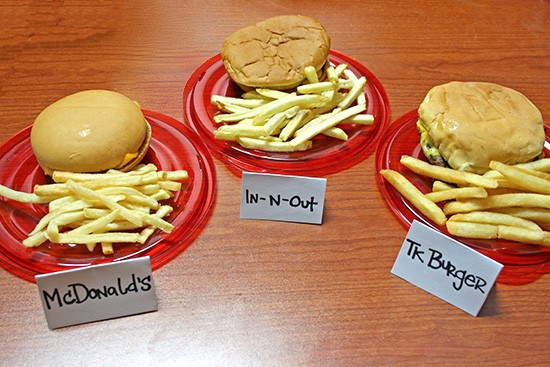
Many of us have heard this rumor: that if you leave a McDonald's hamburger out, indefinitely, it will never go moldy.
Plausible enough, right? The average McDonald's meal is filled with more mystery than the average show on Coast to Coast AM, right? Its nutritional value is so dismal we'd be better off eating cardboard, right? So, it would make sense that something so fake, so artificial, and so full of preservatives would not be able to house mold.
So, we at the Weekly, being as eager to jump on the McDonald's-hating bandwagon as everyone else decided to put this rumor to the test. Being the mature and reputable media organization that we are, it seemed that our results would somehow be more accurate. We would join the ranks of amateur experimenters like the staff at
Refinery29 and good ol'
Morgan Spurlock in our quest for more trash talk on fast food. Except, we decided to take things a step further. We decided to test McDonald's moldabilty against our local favorites–In-N-Out and TK Burger. Surely, these meals made from “real” ingredients would spore before our eyes. The results follow, and promise to be surprising, shocking, disgusting, and childhood-destroying, but most importantly, informative.
]
WEEK ONE
I learned in my college biology class, where I paid as little attention as possible, that experiments must follow highly rigorous steps and protocols to find accurate results. So when it came to setting up our fast-food experiment, I had to eliminate the variables. I purchased a small French fry and plain cheeseburger from McDonald's, In-N-Out, and TK Burger all in the same afternoon, one consecutively after the other, and brought them into the office.
Next, I set up shop on a desk in an undisturbed location, aka an unused office. I gingerly unwrapped each item and placed them on the lids of newly bought, plastic Tupperware, from Wal-Mart. Then, I set the Tupperware housing on top of the lids and popped them in place. This created an ultra-un-scientific container where passersby could survey the experiment without actually smelling it.
WEEK TWO
I returned to the office the next week and excitedly flipped on the lights in the um…lab. Safely, sealed within their containers, the fast food had begun to change. I thought that there would be flecks here and there, but the amount and the particular hosts were surprising.
The McDonald's fries were covered a third of the way with black-and-white fuzz. What is this trickery!? In Morgan Spurlock's version of the experiment, the burger went moldy within the first week but the fries never went moldy…ever! Yet our fries were spawning mutant bacteria, while the cheeseburger looked good enough to eat.
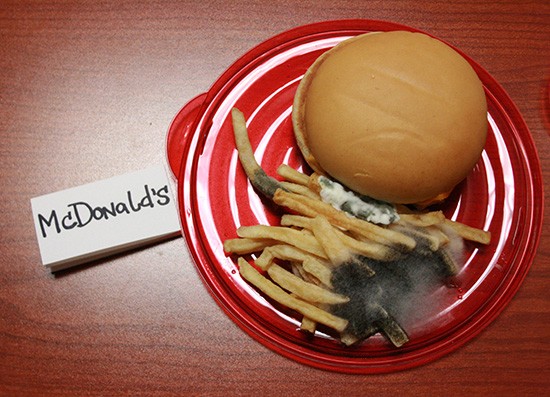
TK Burger, on the other hand, was having the opposite experience. The cheeseburger had a patch of white and blue fuzz that looked to be the consistency of suede, while the fries were unscathed. This meal did, however, have a stronger scent when uncovered than the McDonald's.
Yet here comes the really disturbing discovery, the one that surprised us all. In-N-Out, upon inspection had almost no visual differences from the first day it was placed in the container. My perfect, natural, In-N-Out: what is happening to you?! The fries looked normal; the, burger too. The only sign that it had been sitting out for a week was a small white fringe that hung off of the edge of the bun like soft icicles. Then to add insult to injury, In-N-Out undoubtedly smelled the worst out of its competitors.
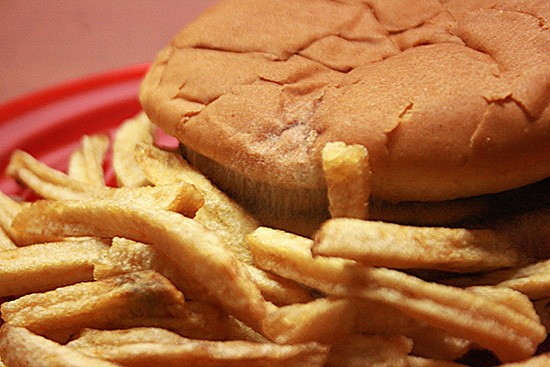
[
WEEK THREE
I entered the third week with high hopes for In-N-Out. At this point, the surprise of the almost-immediate presence of mold on McDonald's and TK Burger had worn off. Now, I really only cared about rooting for my beloved, family-owned chain. The onlookers at the Weekly and I could not have been more disappointed.
McDonald's and TK Burger's mold amount had doubled in size, shape, and color. They both now boasted fur coats with shades of white, blue, grey, and black. The McDonald's fries were now more than halfway covered, and the bun was almost completely covered in black spores. TK Burger's fries were still pretty intact, while the burger bun started to look like a sick cowhide. In-N-Out, however, looked exactly as it had the week before…and still smelled terrible.
WEEKS FOUR – SIX
The next three weeks followed in the same, disappointing fashion. McDonald's seemed to win the contest, growing progressively moldier each week. TK Burger's fries finally succumbed and were covered in big fluffy fuzz, while the burger became an even more heavily splotched canvas. McDonald's was almost all black with tight moldy spores and looked rather menacing, while TK Burger was almost all white with big fluffy mounds that looked like fur balls.
And yet, after six weeks of being left out, the In-N-Out still looked hardly different from the first day. The French fries maintained a perfect condition, except for starting to look a little droopy and sad (can't blame 'em.) The burger's small patch of fringe did not grow nor change in color, but was only joined by a light, white sprinkling on the bun.
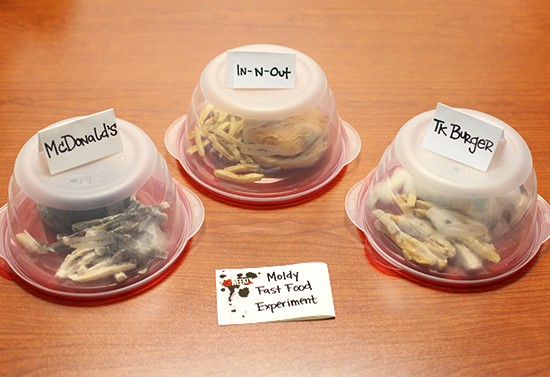
After taking the last portraits of these moldy, and not so moldy, beasts, I discarded the experiment. I knew that our version was no more perfect than any of its predecessors, but I didn't understand how all of our fast-food experiments could come out so differently. Supposedly, people had left out McDonald's for a year with no mold at all. Morgan Spurlock's burger grew mold, but his fries did not. And our McDonald's…well, it's probably infecting other poor, unsuspecting food in the trash with its demon babies as we speak. So, I decided to consult a food science expert in hopes of understanding this a little more.
THE FACTS
After a few emails and phone calls with associates from UCI and Cal Poly Pomona, I finally tracked down a woman who would give me some sort of answer. Her name is
Bonny Burns-Whitmore and she is a professor at Cal Poly Pomona in the department of Human Nutrition and Food Science. Burns-Whitmore's response was short and simple, but it made a lot of sense, and well, makes us amateur experimenters look pretty stupid.
While “it is an interesting observation,” she began, ” I would not call it a scientific experiment.” Smiley Face. She explained that these observations are only noting the visual presence of mold which, in real labs, is only the first part of observation. Second, she explained that there are way too many variables in these “experiments” to say if the components of the ingredients of the food are affecting the molding process. There are way too many factors that have played into the kind of bacteria that the food has been exposed to. For instance, if Fast Food Frank takes a dump, doesn't wash his hands, and then wraps up your burger–a minute piece of bacteria on his pinky could touch the food and that may change what happens next. Even invisible bacteria on the desk in our office could have come into contact with the food and changed the results.
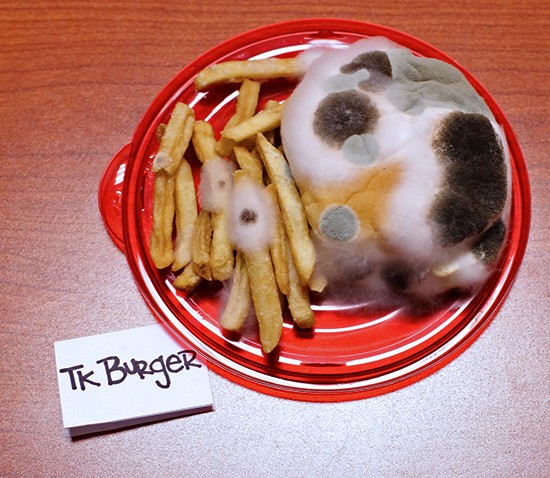
Burns-Whitmore's explanation, along with crushing my dreams of having an honest experiment, completely debunks the myth that fast food, with its many preservatives and fillers will not go moldy. Unless a real lab, with real scientists, and controlled variables test this rumor, there is no way to know the truth.
However, this realization may point to a bright side in our experiment, and brings me to another unscientific, yet happy hypothesis. If bacteria from unclean utensils or hands can spawn mold, then perhaps a cleaner environment with better handling would produce less mold. Meaning that In-N-Out's results, although strange, could reflect an absence of foreign bits, bacteria, and germs! Ok…fine, maybe it's a long shot, but it helps me eat in peace.
Follow Stick a Fork In It on Twitter @ocweeklyfood or on Facebook! And don't forget to download our free Best Of App here!







ew!